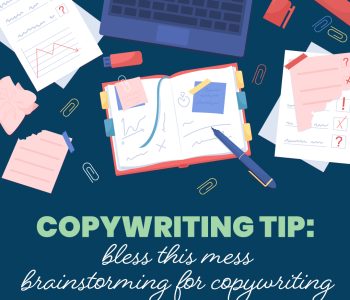
It’s a truth universally acknowledged that a piece of writing does not *POOF* suddenly appear on the page or screen. Before you get to the perfectly polished final draft, it’s a good idea to sit down with your unorganized thoughts for a constructive brainstorming session.
Embracing the brainstorming portion of the writing process is valuable for creative work like copywriting because it often leads to unexpected discoveries about your topic and helps to structure your content. Also, if you are suffering from writer’s block, brainstorming is a terrific way to spark ideas and refine your points.
Whether you’re working on a blog, web page content, social media post, or other type of writing, here are a few ways in which brainstorming is helpful:
- Idea Generation: Brainstorming allows you to explore multiple angles, concepts, and approaches to a topic. It encourages free-flow thinking and even unconventional ideas that can lead to fresh, engaging copy that stands out. A good brainstorming session also can result in innovative headlines, hooks, and messaging that capture attention.
- Audience-Centric Approach: Effective copy speaks directly to the audience. By brainstorming, you can develop content that addresses specific concerns, making the copy more relevant and persuasive.
- Refining the Message: Clarity and precision are essential in copywriting. Brainstorming helps ensure that your message is concise, powerful, and on-brand.
- Creative Problem-Solving: When faced with a writing challenge, brainstorming helps explore alternative solutions or fresh approaches. It prevents you from getting stuck in a creative rut and leads to more dynamic and engaging copy that connects with your readers.
Incorporating brainstorming into the copywriting process helps you create content that has a strong impact and effectively communicates a brand’s message.
The Importance of Messy Brainstorming
What is the key to really effective brainstorming? Make it chaotic! Put that “brain dump” on the page and let all of your ideas out. Check out these reasons why messy brainstorming is magical:
- Sparks Creativity: The lack of structure in messy brainstorming allows for uninhibited creativity. You can think outside the box (without self-editing!), which often leads to “a-ha!” moments.
- Breaks Through Mental Blocks: Messiness disrupts rigid thought patterns, helping you push past creative blocks. The freedom to jot down incomplete thoughts, tangents, or seemingly unrelated ideas can lead to imaginative results. This open-ended process uncovers new approaches to your topic.
- Encourages Risk-Taking: When the focus is on idea generation rather than perfection, you feel more comfortable experimenting. Messy brainstorming reduces fear of failure; taking creative risks can lead to innovative copy that speaks to your audience.
- Captures Unfiltered Ideas: Messy brainstorming captures thoughts in their early stages, without overthinking or filtering. Sometimes the most powerful ideas are in their initial, unpolished state. These raw ideas can be shaped into something great during later revision stages of the writing process.
- Leads to Surprising Connections: Allowing a free flow of ideas often results in connections that wouldn’t have surfaced in a more structured process. Unexpected associations between ideas lead to new perspectives and even solutions.
- Inspires Momentum: The fast pace of messy brainstorming helps maintain your creative momentum, allowing you to generate a breadth of ideas that you can turn into structured, refined content. This momentum sustains your creative energy!
Importantly, don’t edit while you write! Editing during the brainstorming stage inhibits the flow of ideas. By embracing the messy brainstorming process, you give yourself the freedom and flexibility to explore unexpected ideas.
Fun with Brainstorming
Sometimes, the most creative ideas come from combining or reworking seemingly unrelated thoughts. To set you on your path of copywriting freedom, try this brainstorming technique called Looping. Schedule at least 20 to 30 minutes for this exercise.
Looping
- Write down your topic at the top of a blank document. You may wander from this topic as you type, which is just fine—you’ll write your way back.
- Write non-stop for 10 minutes, starting with the first thing that comes to your mind. Type rapidly without looking back to reread or correct anything—keep it moving! The key to effective Looping is to never stop writing.
- If you run out of ideas, you can write phrases such as “I’m stuck” or “I don’t know what to write about” or “I have nothing else to say.” This will keep your mind from wandering too far off and, believe it or not, lead you to new ideas.
- At the end of 10 minutes, pause to reread what you have written. Highlight the sentence or two that you see as the most important.
- Next, copy the highlighted text at the top of a new, blank document and start the Looping process from the beginning.
Brainstorming with a relaxed, playful mindset during the Looping exercise really encourages you to have fun with ideas, where seemingly unrelated or wild ideas can inspire your work.
Embrace the Mess
Messy brainstorming creates a judgment-free zone where every idea, no matter how wild or unpolished, is allowed to flourish without the pressure of perfection. By letting go of the need for perfection, you open yourself up to new insights that you may otherwise overlook.
As you transition into the remaining stages of the writing process—drafting, revising, editing—and your ideas are on the page, then it’s time to structure your content and focus on creating a finished, polished piece. But until then, go ahead and practice some messy brainstorming and unleash your creativity!

